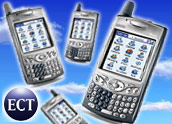
The emergence of smaller, more powerful handheld devices and the spread of high-speed mobile networks have enterprise software developers scrambling to meet demand for portable versions of their flagship applications.
Research In Motion got a jump on the market with the BlackBerry’s secure and reliable e-mail delivery capabilities. Competitors, including Motorola, Nokia and Sony Ericsson, are all vying for a share of the market. Given recent enhancements made to the iPhone, Apple has to be added to the list of contenders. But is the current crop of smartphones and PDAs really up to the task?
Mobile BI, CRM and ERP
The biggest names in enterprise software — Microsoft, Oracle and SAP prominent among them – are developing more powerful portable versions of their applications. Business intelligence (BI), customer relationship management (CRM) and enterprise resource planning (ERP) applications are notoriously and somewhat necessarily heavyweight applications, however, and mobile enterprise users — primarily salespeople and field service staff — are looking for more than simply scaled-down, lightweight versions of them.
“Besides apps that are used for e-mail and personalized contacts and calendar, we’re seeing some additional traction amongst CRM apps — sales, field service. There are also sparks of interest amongst inventory management and logistics apps,” Forrester Research principal analyst Peter Marston told CRM Buyer.
“From a features and functionality standpoint on the CRM apps, organizations aren’t looking for the applications to do complicated algorithms, rather they are looking to the mobile apps to provide field users with more customer related information, such as service call information that the customer has asked for in the past, and what sorts of things that a customer has purchased before.”
Top 3 Mobile Devices for the Enterprise
Mobile device operating systems, systems integration and interoperability are key elements when it comes to the ability of mobile devices to support enterprise applications. Weight and form factors clearly impose constraints on the features and functionality that can be incorporated in them.
“Previously, mobile apps tended to be focused on extending the line-of-business app, like CRM or order management,” Marston commented. “Now, the vendors are working on making their solutions plug into other systems easier — out of the box capability — to enable stronger cross-visibility.”
Making his choice of top three mobile devices for the enterprise, Marston chose to base his assessment on operating system, ranking RIM’s BlackBerry, Windows Mobile and Palm devices one, two and three in that order.
“Besides RIM, there are Windows Mobile Devices, Palm Devices, Nokia devices, and iPhone devices that are being uses for enterprise mobile apps. From what I’ve seen, RIM and Windows Mobile support the vast majority of mobile enterprise apps; that includes e-mail. I think the chief strengths of Blackberries include versatility and cost. BlackBerry devices can support a variety of enterprise mobile apps on the device and device costs range from $100 – $200, on average.”
Keys to Choice
The one drawback for BlackBerry is its browser experience, Marston continued. “The browser is somewhat kludgy compared to the iPhone’s browser. It can be difficult to navigate, and users sometimes must flywheel down to the bottom of pages to access links or enter data.
Explaining his choice of criteria, “I chose to put OS’s instead of devices because Palm offers devices, like the Treo, that operate on the Windows platform.” Moreover, “there are constraints for some handheld solutions running on different operating systems,” he explained.
“For example, Oracle-Peoplesoft CRM has a mobile handheld solution that runs on a Windows mobile device, but not a BlackBerry. And Microsoft Dynamics CRM runs on a Windows mobile device, but not a BlackBerry. So if you’re a buyer running those solutions as your enterprise CRM apps and want to extend those capabilities out to BlackBerry devices that you’ve already rolled out for e-mail, you face a challenge.”
That’s opened a need and opportunities for mobile middleware vendors, such as Antenna, Dexterra, Vaultus and Vettro, Marston noted. “They offer a software layer that allows organizations to extend their CRM application to multiple device types.” Another vendor and solution only adds complexity to vendor management, however, he pointed out.
An Increasingly Crowded Market
“Devices definitely play a large role in managing the deployment of mobile applications. From a developer’s perspective, they must take into account the operating system and capabilities of the phone,” commented Scott Lane, director of business development and applications for Sprint.
“For many developers, ensuring their software is supported on many phones can be costly. This is where our Professional Developers Program plays a large role, which provides the benefit of access to the majority of Sprint’s restricted APIs (application programming interfaces) required to permit more sophisticated applications, plus enhanced technical support and access to the certification process.
BlackBerry devices are just a few of the many devices that support mobile apps for business, Lane said. “Sprint has a wide range of solutions that can address our customers’ needs, regardless of the device they are carrying. Most smart phones can support a variety of business mobile apps. And most devices are compatible with GPS-based business applications, including several rugged devices that are well suited for tough business environments,” he pointed out.
Oracle’s Mobility Drive
“Even the most current mobile devices still provide a small fraction of the bandwidth, screen size and memory available to desktop-based applications,” commented Lenley Hensarling, Oracle’s group vice president of application development. “Mobile applications must be designed to function well in such a limited environment.”
Having focused on building strong database and middleware capabilities into its platform, Oracle is well placed to launch several key enterprise applications for mobile platforms, Hensarling told CRM Buyer.
The first of these came in April with the release of the Oracle Mobile Sales Assistant for BlackBerry, a task-based mobile application which makes it easier for sales reps to access critical customer information while on the go, he recounted. “In addition, we launched the Oracle Mobile Business Indicators to coincide with the launch of the Apple App Store on July 11th 2008.”
Oracle Mobile Business Indicators enables users to tap into and make use of Oracle Business Intelligence Applications, including financial, human resources, supply chain, and CRM analytics, as well as analytical alerts generated by Oracle Delivers, an integrated component of Oracle Business Intelligence Enterprise Edition Plus (OBIEE), Hensarling explained.
Looking to provide users the leverage to make use of as full a set of capabilities as possible, Leveraging full advantage of the Apple iPhone mobile platform, Oracle Business Indicators is built as a native iPhone application that offers “highly intuitive and flexible features including browse, search, and favorites for a superior overall end user experience,” he added.
Oracle plans to follow its initial iPhone release by adding “support for key ERP business approval processes with rich analytical context,” Hensarling said, as well as releasing rich CRM solutions for the iPhone, such as for lead and account management, he added.





















































Social CRM
See all Social CRM